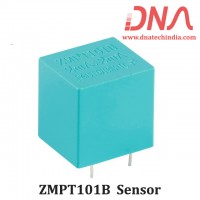Potential Difference |
|
The voltage difference between any two points in a circuit is known as the Potential Difference, pd or Voltage Drop and it is the difference between these two points that makes the current flow. Unlike current which flows around a circuit in the form of electrical charge, potential difference does not move it is applied. The unit of potential difference is the volt and is defined as the potential difference across a resistance of one ohm carrying a current of one ampere. In other words, V = I.R |
|
Ohm's Law states that for a linear circuit the current flowing through it is proportional to the potential difference across it so the greater the potential difference across any two points the bigger will be the current flowing through it. For example, if the voltage at one side of a 10Ω resistor measures 8V and at the other side of the resistor it measures 5V, then the potential difference across the resistor would be 3V ( 8 - 5 ) causing a current of 0.3A to flow. If however, the voltage on one side was increased from 8V to say 40V, the potential difference across the resistor would now be 40V - 5V = 35V causing a current of 3.5A to flow. The voltage at any point in a circuit is always measured with respect to a common point, generally 0V. |
|
For electrical circuits, the earth or ground potential is usually taken to be at zero volts (0V) and everything is referenced to that common point in a circuit. This is similar in theory to measuring height. We measure the height of hills in a similar way by saying that the sea level is at zero feet and then compare other points of the hill or mountain to that level. In the same way we call the common point in a circuit zero volts and give it the name of ground, zero volts or earth, then all other voltage points in the circuit are compared or referenced to that ground point. The use of a common ground or reference point in electrical schematic drawings allows the circuit to be drawn more simply as it is understood that all connections to this point have the same potential. For example: |
|
|
Potential Difference |
|
|
|
As the units of measure for Potential Difference are volts, potential difference is mainly called voltage. Individual voltages connected in series can be added together to give us a "total voltage" sum of the circuit as seen in the resistors in series tutorial. Voltages across components that are connected in parallel will always be of the same value as seen in the resistors in parallel tutorial, for example. |
|
for series connected voltages, |
|
VT = V1 + V2 + V3 ..... etc. |
|
or parallel connected voltages, |
| VT = V1 = V2 = V3 ..... etc. |
|
|
Example No1 |
|
By using Ohm's Law, the current flowing through a resistor can be calculated. For example, Calculate the current flowing through a 100Ω resistor that has one of its terminals connected to 50 volts and the other terminal connected to 30 volts. |
|
Voltage at terminal A is equal to 50v and the voltage at terminal B is equal to 30v. Therefore, the voltage across the resistor is given as: |
|
VA = 50v, VB = 30v, therefore, VA - VB = 50 - 30 = 20v |
|
The voltage across the resistor is 20v, then the current flowing through the resistor is given as: |
|
I = VAB ÷ R = 20V ÷ 100Ω = 200mA |
|
|
Voltage Divider |
|
We know from the previous tutorials that by connecting together resistors in series across a potential difference we can produce a voltage divider circuit giving ratios of voltages with respect to the supply voltage across the series combination. This then produces a Voltage Divider network that only applies to resistors in series as parallel resistors produce a current divider network. Consider the circuit below. |
Voltage Division |
|
|
|
The circuit shows the principal of a voltage divider circuit where the output voltage drops across each resistor, R1, R2, R3 and R4 are referenced to a common point. For any number of resistors connected together in series the total resistance, RT of the circuit divided by the supply voltage Vs will give the circuit current as I = Vs/RT, Ohm's Law. Then the individual voltage drops across each resistor can be simply calculated as: V = IxR. |
|
The voltage at each point, P1, P2, P3 etc increases according to the sum of the voltages at each point up to the supply voltage, Vs and we can also calculate the individual voltage drops at any point without firstly calculating the circuit current by using the following formula. |
|
|
Voltage Divider Equation |
|
|
|
Where, V(x) is the voltage to be found, R(x) is the resistance producing the voltage, RT is the total series resistance and VS is the supply voltage. |
|
Then by using this equation we can say that the voltage dropped across any resistor in a series circuit is proportional to the magnitude of the resistor and the total voltage dropped across all the resistors must equal the voltage source as defined by Kirchoff's Voltage Law. So by using the Voltage Divider Equation, for any number of series resistors the voltage drop across any individual resistor can be found. |
|
Thus far we have seen that voltage is applied to a resistor or circuit and that current flows through and around a circuit. But there is a third variable we can apply to resistors. Power is a product of voltage and current and the basic unit of measurement of power is the watt. |
|
In the next tutorial about Resistors, we will examine the power dissipated (consumed) by resistance in the form of heat and that the total power dissipated by a resistive circuit, whether it is series, parallel, or a combination of the two, we simply add the powers dissipated by each resistor. |
|
|
| Reproduced with permission from Wayne Storr |
| ( http://www.electronics-tutorials.ws/resistor/res_6.html ) |






